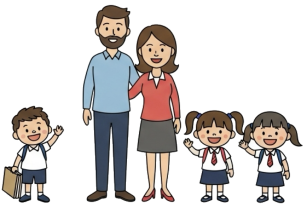
Question More, Action Knowledge.
Remember, at QMAK, we don’t just teach; we empower. We don’t just inform; we inspire. We don’t just question; we act. Become a Gold Member, and let’s unlock your child’s full potential, one question at a time.
Back to Mind Explorers
![]()
This exercise helps children develop empathy, compassion, and a more forgiving perspective towards themselves and others. By imagining that everyone is doing the best they can, children learn to look beyond surface-level behaviors and consider the underlying factors that may contribute to a person’s actions or struggles.
This shift in perspective can foster greater patience, understanding, and kindness in interpersonal relationships. When children learn to assume positive intent and recognize that people are often doing their best given their unique circumstances, they can approach conflicts and challenges with a more open and compassionate mindset.
Moreover, by extending this compassionate perspective to themselves, children can develop greater self-acceptance and resilience. When they understand that their own struggles or mistakes do not define them and that they are always doing their best, they can cultivate a more supportive and nurturing inner dialogue.
Hey there, young empathy explorer!
Today, we're going on a special journey called "The Compassion Quest."
We'll be using our imagination to think about the world in a different way.
Have you ever wondered what it would be like if everyone in the world, including you, was doing the very best they could?
In this game, we'll explore what that might mean and how it can help us be kinder to ourselves and others.
Are you ready to embark on this quest for compassion?
1. Ask the child to imagine a world where everyone is doing the best they possibly can. Encourage them to think about what that might look like in their daily lives.
2. Have the child consider different people they encounter, such as friends, family members, teachers, or even strangers. Ask them to imagine that each person is doing their best, even if it doesn’t always seem that way.

3. Encourage the child to think about times when they themselves have struggled or made mistakes.
Ask them to consider the possibility that, in those moments, they were doing the best they could with the resources, knowledge, and skills they had at the time.

4. Help the child understand that when we assume others are doing their best, it can lead to greater compassion, empathy, and understanding. When we extend this same compassion to ourselves, it can help us be more forgiving and kind when we face challenges or setbacks.
5. Encourage the child to practice this perspective in their daily life, reminding themselves that everyone, including themselves, is doing the best they can.

To further explore the concept of compassion and the power of assuming positive intent, consider introducing your child to the book “The Invisible Boy” by Trudy Ludwig.
This beautifully illustrated story follows the journey of a quiet and often overlooked boy named Brian, who feels invisible in his classroom. When a new student named Justin arrives, Brian extends a small act of kindness that sets in motion a chain of events that helps him find connection, confidence, and a sense of belonging.
1. Who is the main character of the story?
a) Justin
b) Brian
c) Emilio
d) Madison
2. Why is Brian described as “invisible”?
a) He can turn invisible at will
b) He wears camouflage clothes
c) He’s often overlooked and left out by others
d) He’s a ghost
3. What does Brian love to do?
a) Play sports
b) Sing loudly
c) Draw and use his imagination
d) Tell jokes
4. What happens when the teacher asks the class to get into groups?
a) Brian is the first one chosen
b) Brian is left out
c) Brian forms his own group
d) Brian goes home
5. Who is the new student that joins Brian’s class?
a) Justin
b) Emilio
c) Madison
d) Sarah
6. How does Brian first interact with the new student?
a) He ignores him
b) He leaves him a welcome note with a drawing
c) He shows him around the school
d) He invites him to play at recess
7. What special talent does the new student share with the class?
a) Juggling
b) Singing
c) Dancing
d) Cooking
8. How does Brian help the new student during the class project?
a) He does all the work for him
b) He offers ideas for their project
c) He asks the teacher to change groups
d) He doesn’t help at all
9. What change do we see in Brian by the end of the story?
a) He becomes actually invisible
b) He transfers to a new school
c) He starts to become more visible as he’s included
d) He decides he prefers being alone
10. What is the main message of the book?
a) It’s better to be invisible
b) One small act of kindness can make a big difference
c) New students should always be left alone
d) Drawing is the most important skill
1. b) Brian
2. c) He’s often overlooked and left out by others
3. c) Draw and use his imagination
4. b) Brian is left out
5. a) Justin
6. b) He leaves him a welcome note with a drawing
7. d) Cooking
8. b) He offers ideas for their project
9. c) He starts to become more visible as he’s included
10. b) One small act of kindness can make a big difference
Verse 1:
Imagine a world where everyone tries
To do what they can with all they comprise
Your friends and your family, strangers too
All doing their best, just like you
Pre-Chorus:
It’s not always easy to see
But kindness is the key
Chorus:
Everybody’s trying their best
Put your heart to the test
With patience and love, we’ll go far
Compassion’s our guiding star
Verse 2:
When you make a mistake, don’t be too hard
Remember you’re doing your best, even when it’s hard
Look at others with gentler eyes
Their struggles and efforts, you’ll recognize
(Pre-Chorus)
(Chorus)
Bridge:
In this quest for understanding
We’re all just souls expanding
With empathy as our guide
We’ll stand right by each other’s side
(Chorus)
Outro:
Open your heart, what do you see?
A world full of possibility
Where everyone, including you
Is doing the best they can do

Remember, at QMAK, we don’t just teach; we empower. We don’t just inform; we inspire. We don’t just question; we act. Become a Gold Member, and let’s unlock your child’s full potential, one question at a time.